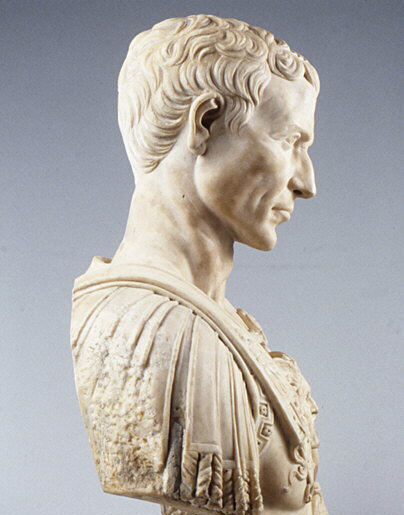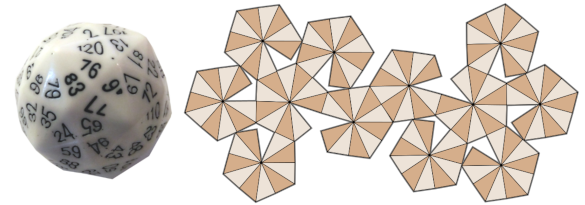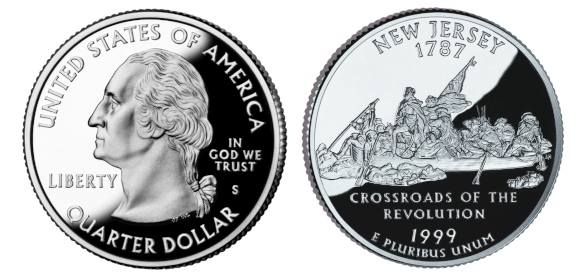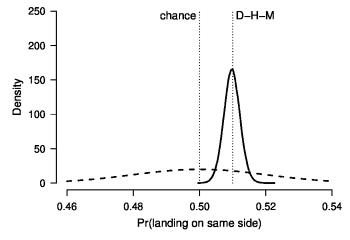Coin Flip
January 8, 2024
Dice were first used in
prehistoric times. The most famous
phrase involving dice, "
alea iacta est (the die is cast)", was spoken by
Julius Caesar (100 BC- 44 BC) when he brought his
troops across the Rubicon river into
Italy to become
dictator of the
Roman Republic.

Julius Caesar (100 BC- 44 BC).
Caesar was assassinated on the Ides of March (March 15), 44 BC, by a group of Roman Senators. This group of Senators included his friend, Marcus Junius Brutus (c. 85 BC - 42 BC), leading to the famous quotation in Act 3, Scene 1, of William Shakespeare's play, Julius Caesar, "Et tu, Brute (And you, Brutus)."
I was confused as a child when Popeye's nemesis, Bluto, suddenly became Brutus. This was a consequence of an incorrect idea about the copyright owner of the name, Bluto.
(Portion of a Wikimedia Commons image of a marble bust by Andrea Ferrucci (1465-1526), from the Metropolitan Museum of Art)
There are always some
people who attempt to
skew the chance of
success to their
advantage. That's why we see many cases of
insider trading and
cryptocurrency scams, today, and the use of
loaded dice. In
theory, any of the six
cube faces of a die should land with equal
probability when
tossed, and this
concept is used in the
dice game,
craps, and many
board games. A loaded die is a die that's been modified, usually by the insertion of
weights, to enhance the probability of a fall onto a specific face. Dice are so frequently used that there are
Unicode symbols (U+2680 to U+2685) for their six faces.

Left, a photograph of a 120-sided die. Right, a template to create a 120-sided polyhedron by paper folding. I once created a dodecahedron (12-sided polyhedron) from copper-clad printed circuit board material using a similar template for an art project, but I would never attempt a 120-sided figure. (Left image, a 120-sided die by Wintermute115, and right image by Tilman Piesk, both from Wikimedia Commons.)
While
computer pseudorandom number generators are presently the best option for making an arbitrary
yes/no decision, it was common in the past to
flip a
fair coin; that is, a
coin that will land either
heads or
tails with equal
probability. Just as for loaded dice, a weighted coin can skew this probability.
Mathematician,
John Edmund Kerrich (1903-1985), discovered that a coin-sized
wooden disk,
coated on one side with
lead, would land on a
surface with the wooden side up 67.9% of the time when flipped.[1] However, such a coin, flipped and caught in mid-flight, acts as a fair coin. The
mechanics of bouncing on the surface is what
biases a weighted coin.
As can be seen in the figure, below, even an unweighted coin has sufficiently different
decorations on its two sides that might have a slight influence the probability of landing heads or tails. Another influence might be the initial
upwards facing side before the coin flip. The final coin side probability of 46 different
currency denominations was determined with respect to their initial state in a
experiment of 350,757 coin flips by a huge
international research team.[2-3] In this case, coin flipping was defined as flipping a coin into the air with your
thumb, and then
catching it in your
hand.[2]

The state quarter coin for New Jersey, issued on May 17, 1999. This coin commemorates George Washington's crossing the Delaware River on the night of December 25-26, 1776. (Heads side and tails side images of the New Jersey State quarter coin, both from Wikimedia Commons. Click for larger image.)
Team members were from the
University of Amsterdam (Amsterdam, Netherlands), the
University of Kassel (Kassel, Germany), the
Katholieke Universiteit Leuven (Leuven, Belgium),
Georg August University of Göttingen (Göttingen, Germany),
Hasselt University (Hasselt, Belgium), the
Gutenberg School Wiesbaden (Wiesbaden, Germany),
Justus Liebig University Giessen (Giessen, Germany), the
University of Zürich (Zürich, Switzerland), the
Utrecht University (Utrecht, Netherlands),
CNRS, Lyon Neuroscience Research Center (Lyon, France),
Vrije Universiteit Amsterdam (Amsterdam, Netherlands),
Radboud University (Nijmegen, Netherlands), and
ELTE Eotvos Lorand University (Budapest, Hungary).[2]
The experiment was done to test the
theory of
human coin tossing
published in 2007 by
Persi Diaconis,
Susan Holmes, and Richard Montgomery, known as the D-H-M
Model.[2-3] The model predicts that an ordinary coin tends to land on the same side it started when flipped.[2-3] The D-H-M model predicts just a small probability difference, 51/49, as compared with the presumed 50/50 outcome.[2] The presumed
physical process is that a flipped coin will spend more time in flight with its initial side facing up, and this makes landing on that side more likely.[3]

Probability of coins landing on the same side from which they've started. The experimental data confirm the prediction from the Diaconis, Holmes, and Montgomery (D-H-M) Model of coin flipping.[4]
(Potion of fig. 1 of ref. 2.[2] Click for larger image.)
The experiment, which involved 48 people flipping coins
minted in 46
countries and making a total of 350,757 coin flips, showed that
vigorously flipped coins have a slightly larger probability (0.508 at the 95%
confidence level) of landing on the same side as flipped.[2,4] Most interestingly, some people uniformly achieve a 50/50 split when flipping coins, contrary to the D-H-M model.[2-3] So, how significant is this finding? If you flip a coin a 1,000 times, betting $1 each time, your
knowledge of this result might earn you $19.[3] A reasonable
cycle time of four flips per
minute will pay you $4.56/
hour. The
minimum wage in
Tikalon's state of New Jersey is $14.13/hour.
References:
- J. E. Kerrich, "An experimental introduction to the theory of probability," (1946, Einar Munksgaard: Copenhagen, Denmark). Unfortunately, not freely accessible.
- František Bartoš, Alexandra Sarafoglou, Henrik R. Godmann, Amir Sahrani, David Klein Leunk, Pierre Y. Gui, David Voss, Kaleem Ullah, Malte J. Zoubek, Franziska Nippold, Frederik Aust, Felipe F. Vieira, Chris-Gabriel Islam, Anton J. Zoubek, Sara Shabani, Jonas Petter, Ingeborg B. Roos, Adam Finnemann, Aaron B. Lob, Madlen F. Hoffstadt, Jason Nak, Jill de Ron, Koen Derks, Karoline Huth, Sjoerd Terpstra, Thomas Bastelica, Magda Matetovici, Vincent L. Ott, Andreea S. Zetea, Katharina Karnbach, Michelle C. Donzallaz, Arne John, Roy M. Moore, Franziska Assion, Riet van Bork, Theresa E. Leidinger, Xiaochang Zhao, Adrian Karami Motaghi, Ting Pan, Hannah Armstrong, Tianqi Peng, Mara Bialas, Joyce Y.-C. Pang, Bohan Fu, Shujun Yang, Xiaoyi Lin, Dana Sleiffer, Miklos Bognar, Balazs Aczel, and Eric-Jan Wagenmakers, "Fair coins tend to land on the same side they started: Evidence from 350,757 flips," arXiv, October 10, 2023.
- Bob Yirka, "Flipped coins found not to be as fair as thought," Phys.org, October 11, 2023
- Persi Diaconis, Susan Holmes, and Richard Montgomery, "Dynamical bias in the coin toss," SIAM Review, vol. 49, no. 2 (2007), pp. 211-235, https://doi.org/10.1137/S003614450444643. A PDF file can be found here.
- František Bartoš, "How fair is a fair coin flip?," Open Science Framework Website, November, 2022.
Linked Keywords: Dice; prehistory; prehistoric times; phrase; alea iacta est (the die is cast); Julius Caesar (100 BC- 44 BC); troop; crossing the Rubicon; Rubicon river; Italy; dictatorship; dictator; Roman Republic; assassination of Julius Caesar; Ides of March (March 15); Roman Senate; Roman Senator; friendship; friend; Marcus Junius Brutus (c. 85 BC - 42 BC); quotation; act (drama); scene (performing arts); William Shakespeare; Play (theater); Julius Caesar (play); Et tu, Brute (And you, Brutus); confusion; confused; child; Popeye; nemesis; Bluto; Brutus; consequence; error; incorrect idea; copyright; Wikimedia Commons; marble; bust (sculpture); Andrea Ferrucci (1465-1526); Metropolitan Museum of Art; person; people; skew normal distribution; skew the chance; success; advantage; insider trading; cryptocurrency; confidence trick; scam; loaded dice; theory; cube; face (geometry); probability; toss; tossed; concept; dice game; craps; board game; mass; weights; Unicode symbol; photograph; 120-sided; die; pattern; template; polyhedron; origami; paper folding; dodecahedron (12-sided polyhedron); copper; cladding (metalworking); clad; printed circuit board; material; art project; Tilman Piesk; computer; pseudorandom number generator; binary number; yes/no; decision; coin flipping; flip; fair coin; coin; obverse and reverse; heads; tails; mathematician; John Edmund Kerrich (1903-1985); wood; wooden; disk (mathematics); coating; coated; lead; surface; classical mechanics; bias (statistics)">bias; decorative arts; decoration; direction (geometry); upwards; currency; denomination (currency); experiment; international; research; thumb; catch; catching; hand; US Quarter Coin (New Jersey); 50 State quarters; state quarter coin; New Jersey; commemorative coin; George Washington; Washington Crossing the Delaware River; night; University of Amsterdam (Amsterdam, Netherlands); University of Kassel (Kassel, Germany); Katholieke Universiteit Leuven (Leuven, Belgium); Georg August University of Göttingen (Göttingen, Germany); Hasselt University (Hasselt, Belgium); Gutenberg School Wiesbaden (Wiesbaden, Germany); Justus Liebig University Giessen (Giessen, Germany); University of Zürich (Zürich, Switzerland); Utrecht University (Utrecht, Netherlands); CNRS, Lyon Neuroscience Research Center (Lyon, France); Vrije Universiteit Amsterdam (Amsterdam, Netherlands); Radboud University (Nijmegen, Netherlands); ELTE Eotvos Lorand University (Budapest, Hungary); scientific theory; human; scientific literature; publish; Persi Diaconis; Susan Holmes; mathematical model; physics; physical process; Probability of coins landing on the same side from which they've started; data; prediction in science; mint (facility); minted; country; countries; vigorously; confidence interval; confidence level; knowledge; frequency; cycle time; minute; hour; minimum wage in the United States; Tikalon; state of New Jersey.